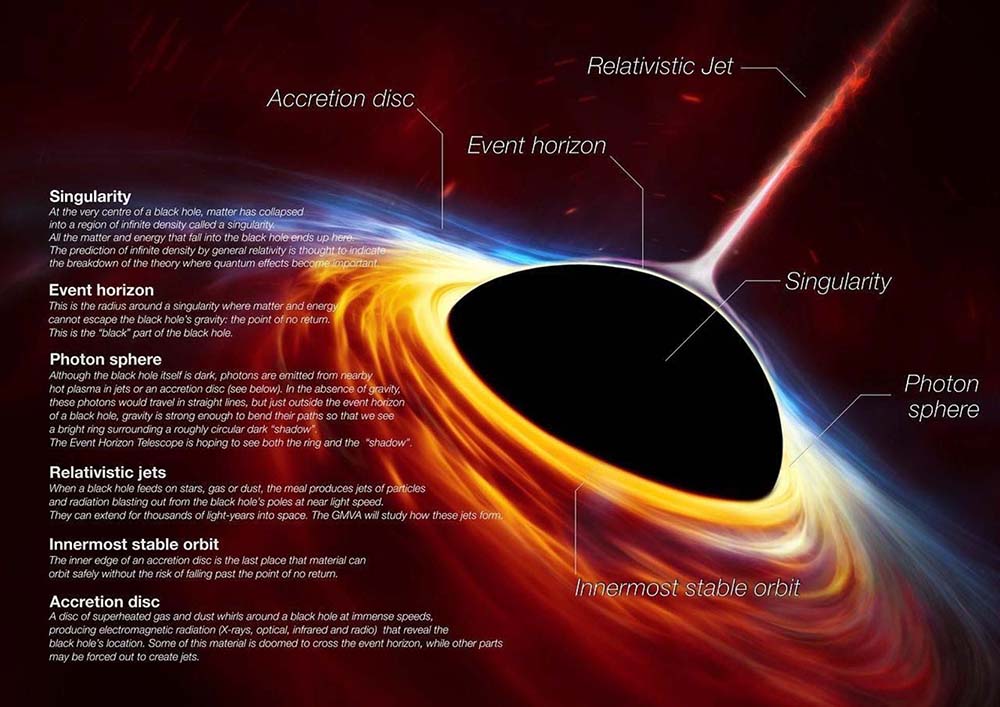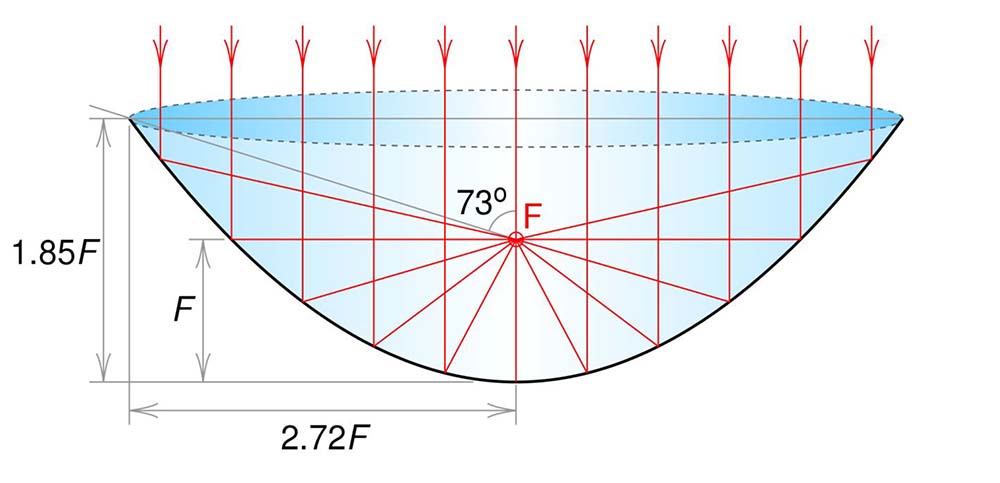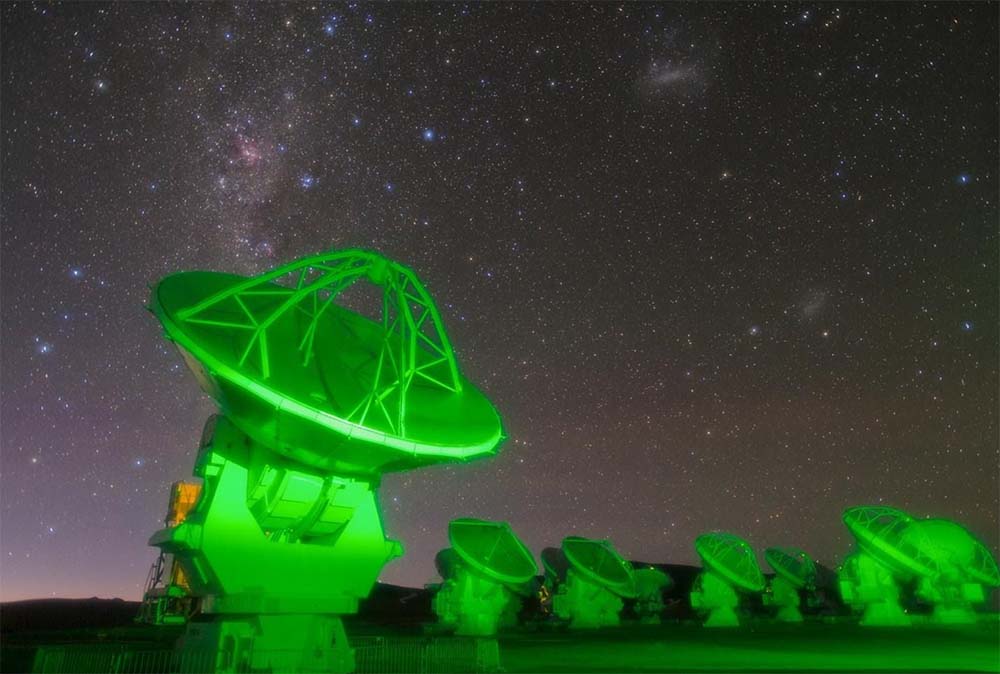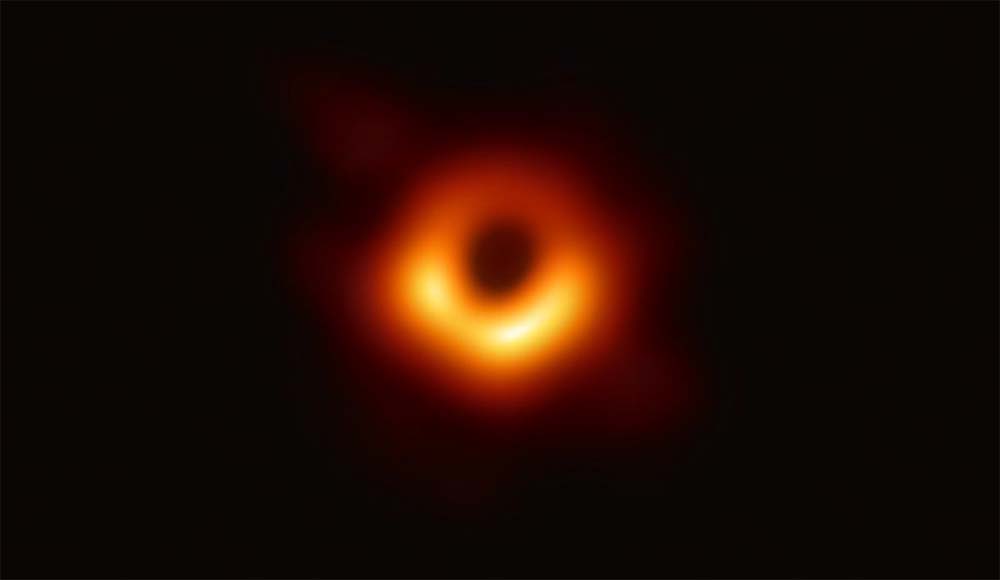Imaging a Black Hole
It may seem impossible to image something that not even light can escape, but it has been done! A serious amount of time and effort went into the first image of a black hole. Read on to learn how scientists imaged something that doesn’t do well with the flash on your camera.
About Black Holes
The goal to image a black hole started in 1999. It took another ten years before the proposal and start of the Event Horizon Telescope collaboration, which brought that goal to completion. The black hole selected for imaging resides in the center of the Messier 87 galaxy, 55 million light years away (324 quintillion miles away). That’s about the same distance as 58.5 quadrillion round trips between LA and NY city, or 8.1 trillion times around Earth. It is far!
Black holes are very special objects - not even light can escape them. They are the remnant of a giant star that was unable to balance the gravitational inward pull, causing the star to collapse in on itself to a point called a singularity. According to general relativity, massive objects curve the fabric of space around them, similar to how a bowling ball would curve a trampoline. This is called the warping of space. Imagine a bowling ball on a very large marshmallow. It would really smoosh and curve the marshmallow around it. Blackholes do this to all the space surrounding them. Black holes do not suck things in like a vacuum. They attract mass, and that mass, if going fast enough, will maintain an orbit around the black hole.
If our Sun suddenly were replaced by a black hole of equal mass, nothing much would happen to Earth’s orbit, although our planet would get rather chilly without the Sun’s light warming it. Real black holes are much more massive than our Sun. Black holes trap nearby gases in their gravitational pull and whip them around in an orbit at immense speeds. The gas material gets very hot and breaks apart into its constituent positive nuclei and negative electrons, not bound together as an atom. This hot mass of free electrons and nuclei is called a plasma. The trapped plasma forms the accretion disk of a black hole – a disk of material gravitationally bound to the black hole. As charged particles go around, they accelerate, causing the emission of electromagnetic radiation. Some of this radiation, as well as radiation created by infalling material, is ejected in jets in directions related to the rotation of the black hole.
Besides the jets, electromagnetic waves (like visible light, X-rays, and microwaves) travel along the warped space around a black hole. A sphere of light, called the photon sphere, defines a boundary where light can still escape. Beyond the photon sphere lies the event horizon of the black hole, the boundary that marks where not even light can escape the warping of space that the black hole creates. All electromagnetic radiation passing the event horizon is unobservable. An informative graphic is shown below.

Artist’s rendition of a black hole based on predictions made by scientists. Credit: ESO, ESA/Hubble, M. Kornmesser/N. Bartmann
We usually see an object when radiation emitted or reflected by it enters our eyes. When we observe someone wearing a black T-shirt, we notice light from the objects surrounding the black T-shirt and a reduction of visible light from the black T-shirt. Our eyes are great detectors for the small band of electromagnetic radiation known as the visible region of the spectrum. Scientists hoped to image the light around the boundary of the black hole and the absence of light within that boundary.
Although an image of a black hole was not possible before 2019, scientists predicted that the electromagnetic radiation from the accelerating plasma and the light of the photon sphere would be observable. The emitted jets of electromagnetic radiation have been observed. It was also predicted that there would be an absence of electromagnetic radiation at the event horizon where not even light can escape. But seeing is believing, and once it became clear that it is possible to image the black hole, scientists began to work on it.
Journey to Earth
To image the blackhole in the Messier 87 galaxy, packets of light energy called photons had to travel for 6000 years through the Messier 87 galaxy, then 55 million years to Earth, then pass through Earth’s atmosphere without interacting with anything but the detector being used to create the image. Some photons do not make this trip as easily as others, and the primary difficulty is when the photons enter Earth’s atmosphere. Visible light has a wavelength of about 0.5 millionths of a meter. Radio waves used to image the black hole were 1.3 millimeters. The resolving power of a telescope gets better for larger diameters of the telescope and smaller wavelengths of light. Although visible light has a smaller wavelength, it also interacts more with Earth’s atmosphere. Radio waves travel much better through Earth’s atmosphere and by linking radio telescopes, e.g., in an array, the effective diameter can be large. It still gets a little dicey with radio waves because water molecules in the atmosphere can absorb them, so scientists try to put their detectors at high altitudes and in dry regions to collect these waves.
Imaging
The Event Horizon Telescope collaboration realized a way, developed years earlier, to get around one of their biggest initial problems. The problem: to image a black hole the telescope had to be the size of Earth itself! It’s just not possible to create a single telescope that big. Some telescopes, such as those created with mirrors for visible light, have an upper limit on their structure – beyond a certain size the mirror would break under its own weight. Radio telescopes are different, they look like a mesh and are often configured in an array. And here comes some truly cool and clever science – but to understand it, it is best to go on an imaginary journey.
Imagine you are looking into a big curved mirror, one that focuses light from far away at a single point, like in the diagram shown. This mirror would image a distant object at that focal point.

A parabolic reflector focuses light from afar which enters with parallel rays, to a single point.
By Cmglee - Own work, CC BY-SA 3.0, https://commons.wikimedia.org/w/index.php?curid=41674932
Now imagine that there are dirt splotches covering up much of the mirror. You would be able to get a few rays from afar focusing at the focal point, but not enough to get a complete image or necessarily a clear image. If you were able to rotate the mirror (while it was still focused at the same object) you would gather more information about what the mirror is imaging because you would be able to gather light from different areas. But it would be important that the light you are gathering from the different clean parts of the mirror are coming from the same object and that they correlate with each other in time.
To get truly good resolution of the black hole in Messier 87, scientists needed a telescope the size of Earth. Now imagine that pieces of this imaginary Earth sized telescope could be like the clean spots on the mirror example above. The clean spots each being different telescopes on Earth. If these smaller telescopes are coordinated just right, they would be able to begin to create the image, but many measurements from different locations all around Earth would be needed.
This is just what the Event Horizon Collaboration did. They had 8 different telescopes all over the Globe (2 in Chile, 2 in Hawaii, 1 in Arizona, 1 in Spain, 1 in Mexico, and 1 in Antarctica), that would simultaneously work to image the black hole. To make sure the telescopes were correlated properly in time, each was fitted with an atomic clock so the data from each telescope could be properly combined. And the collaboration had an assist from Earth’s rotation. As Earth rotated, it allowed the individual telescopes (like the clean spots of the mirrors) to act as a different spot on the larger virtual Earth sized telescope, providing better resolution and imaging.

Atacama Large Millimeter Array, one of the 8 telescope facilities used in imaging a black hole.
By ESO/B. Tafreshi (twanight.org) - http://www.eso.org/public/images/ann13002a/, CC BY 4.0, https://commons.wikimedia.org/w/index.php?curid=23766478
It was not until March of 2017 that the data used to image the black hole in the center of the Messier 87 galaxy was taken, and it took another 2 years to put that data together to create the image.
Collaboration is key
The resulting image involved more than 200 researchers from over 100 institutions, who worked on how to coordinate 8 telescope stations located around the globe to work together. A great deal had to come together for this project to happen. Good weather was needed simultaneously at the different telescope locations, and by pure luck they got it. Each of the telescopes needed to by synchronized, so they developed a way to retrofit each of the telescopes with their own atomic clocks. The data, about 350 trillion bytes per day, needed a way to be stored. They solved it. And then came the issue of processing the data –luckily two computing centers aided with this. Not only that – a great many people came together to sift through the data and support these efforts.
The results are shown below.

Image created from data taken by eight different millimeter wave telescopes around the globe and hundreds of scientists working together. Credit: Event Horizon Telescope Collaboration
The brighter region on the bottom of the black hole is moving near light speeds toward us, the dimmer region spins away from us, providing information that this black hole spins counter clockwise. This black hole is almost the size of our entire solar system and has a mass of 6.5 billion times our Sun’s mass.
Below is a short video put out before the black hole image was created, that explains how the telescopes work together to form an Earth-sized telescope.
References and Resources
[1] The Event Horizon Telescope Collaboration, First M87 Event Horizon Telescope Results. I. The Shadow of the Supermassive Black Hole, Astrophys. J. Lett. 875 (2019)
[2] The Event Horizon Telescope Collaboration, First M87 Event Horizon Telescope Results. II. Array and Instrumentation, Astrophys. J. Lett. 875 (2019)
[3] The Event Horizon Telescope Collaboration, First M87 Event Horizon Telescope Results. III. Data Processing and Calibration, Astrophys. J. Lett. 875 (2019)
[4] The Event Horizon Telescope Collaboration, First M87 Event Horizon Telescope Results. IV. Imaging the Central Supermassive Black Hole, Astrophys. J. Lett. 875 (2019)
[5] The Event Horizon Telescope Collaboration, First M87 Event Horizon Telescope Results. V. Physical Origin of the Asymmetric Ring, Astrophys. J. Lett. 875 (2019)
[6] The Event Horizon Telescope Collaboration, First M87 Event Horizon Telescope Results. VI. The Shadow and Mass of the Central Black Hole, Astrophys. J. Lett. 875 (2019)
[7] Event Horizon Telescope Collaboration Website: https://eventhorizontelescope.org/
[8] Press release to NSF: https://www.nsf.gov/news/special_reports/blackholes/
[9] Video ( 4.3 min) describing how EHT works:
https://www.youtube.com/embed/hMsNd1W_lmE
[10] Video (≈ 4 min) with description of how image was obtained:
https://www.youtube.com/embed/pkTWO0crVng
[11] Documentary about 17.3 minutes with more in depth information:
https://www.youtube.com/embed/omz77qrDjsU
—H.M. Doss














